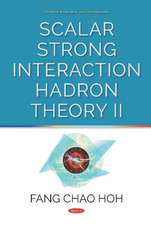Advanced Calculus and its Applications in Variational Quantum Mechanics and Relativity Theory
Autor Fabio Silva Botelhoen Limba Engleză Paperback – 24 iul 2023
The second part reviews applications, specifically in variational quantum mechanics and relativity theory. Topics such as a variational formulation for the relativistic Klein-Gordon equation, the derivation of a variational formulation for relativistic mechanics firstly through (semi)-Riemannian geometry are covered. The second part has a more general context. It includes fundamentals of differential geometry.
The later chapters describe a new interpretation for the Bohr atomic model through a semi-classical approach. The book concludes with a classical description of the radiating cavity model in quantum mechanics.
| Toate formatele și edițiile | Preț | Express |
|---|---|---|
| Paperback (1) | 489.70 lei 6-8 săpt. | |
| CRC Press – 24 iul 2023 | 489.70 lei 6-8 săpt. | |
| Hardback (1) | 1066.72 lei 6-8 săpt. | |
| CRC Press – 13 iul 2021 | 1066.72 lei 6-8 săpt. |
Preț: 489.70 lei
Nou
Puncte Express: 735
Preț estimativ în valută:
93.70€ • 97.84$ • 77.38£
93.70€ • 97.84$ • 77.38£
Carte tipărită la comandă
Livrare economică 16-30 aprilie
Preluare comenzi: 021 569.72.76
Specificații
ISBN-13: 9780367746490
ISBN-10: 0367746492
Pagini: 334
Ilustrații: 19
Dimensiuni: 156 x 234 mm
Greutate: 0.62 kg
Ediția:1
Editura: CRC Press
Colecția CRC Press
ISBN-10: 0367746492
Pagini: 334
Ilustrații: 19
Dimensiuni: 156 x 234 mm
Greutate: 0.62 kg
Ediția:1
Editura: CRC Press
Colecția CRC Press
Cuprins
SECTION I: ADVANCED CALCULUS. The Implicit Function Theorem and Related Results. Manifolds in Rn. SECTION II: APPLICATIONS TO VARIATIONAL QUANTUM MECHANICS AND RELATIVITY THEORY. A Variational Formulation for the Relativistic Klein-Gordon Equation. Some Numerical Results and Examples. A variational formulation for relativistic mechanics based on Riemannian geometry and its application to the quantum mechanics context. A General Variational Formulation for Relativistic Mechanics Based on Fundamentals of Differential Geometry. A New Interpretation for the Bhor Atomic Model. Existence and Duality for Superconductivity and Related Models. A Classical Description of the Radiating Cavity Model in Quantum Mechanics.
Notă biografică
Fabio Silva Botelho obtained a Ph.D, in Mathematics from Virginia Tech, USA in 2009. Prior to that got his undergraduate (1992) and master (1996) degrees in Aeronautical Engineering from the Technological Institute of Aeronautics, ITA, SP, Brazil. From 2004 to 2015 he was an Assistant Professor at the Mathematics Department of Federal University of Pelotas in Brazil. Since 2015 he has worked as an Adjunct Professor at the Department of mathematics of Federal University of Santa Catarina, in Florianopolis, SC, Brazil. His fields of reserach are Functional Analysis, Calculus of Variations, Duality and Numerical Analysis applied to problems in Physics and Engineering. He has published three books, Functional Analysis and Applied Optimization in Banach Spaces (2014), Real Analysis and Applications (2018), both with Springer, and Functional Analysis, Calculus of Variations and Numerical Methods for Models in Physics and Engineering (2020), published by CRC Taylor and Francis. He is also the author of a generalization of the Method of Lines, a numerical method for solving partial differential equations in which the domain of the equation in question is discretized in lines and the concerning solution is written on these lines as functions of the boundary conditions and the domain boundary shape.
Descriere
The approach presented includes detailed and rigorous studies on surfaces in Rn which comprises items such as differential forms and an abstract version of the Stokes Theorem in Rn. The conclusion section introduces readers to Riemannian geometry, which is used in the subsequent chapters.
























